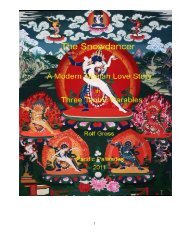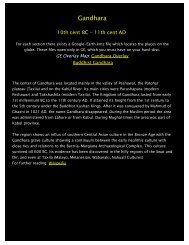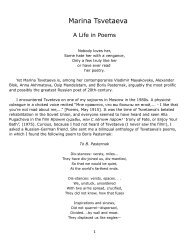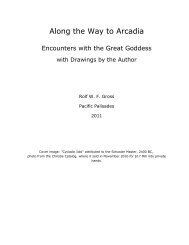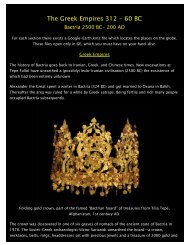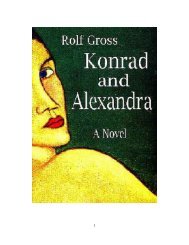listen to its musical message without attaching yourself to the underlying words of the poem."He bowed with a mock-apologetic smile. "Copies of Dehmel’s poem will be available after the performance."The music was indeed exceedingly eloquent. It began in a dark, wistful mood in the bases. The succeeding pessimisticpassage ended in a dramatic culmination, a highly emotional cry for justice, love, or salvation. Thereafter the moodbrightened. A consoling interlude, maybe some higher power trying to elevate the crying soul, led to a vision of a sweet<strong>and</strong> beautiful, celestial realm, forgiveness, heaven, peace?This time the applause was more convincing, most people seemed comfortable with the musical vernacular. Thedissatisfied minority was younger than Schönberg."It describes Wagner arriving at the gates of heaven after the Götterdämmerung," said Friedrich loud enough for peopleto turn around. His sister punched his side.With an annoyed glance at Friedrich his father rose. "Ladies <strong>and</strong> gentlemen, allow me to act as a moderator." Hepronounced the word in English. "I am not a professional musician, but a musically interested layman who has heard thispiece before. Would Herr Schönberg take the trouble <strong>and</strong> elaborate on his initial claim that it musically transcendsWagner?""Unfortunately, my critics are right." Schönberg smiled sadly. "I like Friedrich Dahl’s quip, it hits not far from Dehmel’spoem <strong>and</strong> my personal feelings today. The piece is heavily indebted to Wagner. The treatment of the instruments, themanner of composition, <strong>and</strong> much of its sonority is pure Wagner. I was twenty-two when I wrote this piece. I feltcompelled to profess emotions which the music of Wagner, Mahler, <strong>and</strong> Herrn Strauss’ Tondichtungen had stirred in me."He smiled at Strauss. "The method of developing the variations <strong>and</strong> the disparity of the measures I borrowed fromBrahms. But there are distinct Schönbergian elements too—if you permit me to call them that—the broad-spreadmelodies, the use of contrapuntal confrontations of the bases <strong>and</strong> the melody, <strong>and</strong> a short interlude of three bars ofatonal development. These elements are what I wanted you to hear, because they interest me more <strong>and</strong> more today."He finished his comments with a bow to Richard Strauss, "Much of the success of this piece I owe to the generous <strong>and</strong>courageous support of Herrn Strauss."Strauss mumbled, "I continue to disavow any paternity of this piece," which was greeted with general laughter.Schönberg returned to his lecture. "The last piece was written two months ago by one of my promising students, Herr Dr.Anton von Webern. Anton, would you please st<strong>and</strong>." He extended his arm in the direction of a young, clean-shavenintellectual with glasses, who rose. Two young people applauded. Webern bowed awkwardly."I chose this piece, because Herr von Webern, no longer beholden to the musical giants that held my generation in thrall,composed the kind of music that I have been dreaming of. I believe this very short piece—we once timed it at a mereeight minutes—is a milestone in our search for a new style of composition. It leaves my Verklärte Nacht far behind."It is written for four strings, which is intentional as a thought-provoking deception as well as a way to increase its clarity.Structurally it is not a quartet in the classical sense. It is a tentative experiment, in which Herr Webern tried to use a newstructural <strong>and</strong> tonal approach to composition by going back to Bach’s daring harmonies."I present this piece for the first time here, in order to subject it to your discriminating judgment. It may not produce anunpremeditated hearing pleasure, it does not adhere to a given key, it is atonal throughout. For the time being Webernuses some contrapuntal elements, which he may drop again in the future. However, unlike Bach, the theme, a simple lineof twelve notes you will easily discern in the very beginning, is not repeated as such. Each note of this sequence giveseach of the twelve elaborations that follow a specific musical color."Try to hear this music by visualizing these blocks of color as if they formed a non-figurative, abstract painting, each blockexpressing a specific emotion."He smiled <strong>and</strong> bowed towards the hostess."Herr Webern has dedicated this piece to you, Mrs. Dahl, as a contribution to the controversy of this evening: TheSpiritual in Art, Music <strong>and</strong> Painting."Alex<strong>and</strong>ra sighed. The music, the polemic, <strong>and</strong> the didactic expositions of Herr Schönberg went over her head. All shehad ever heard in Western music was Tchaikovsky’s Swan Lake to which Aunt Sophia had taken her before Otto wasborn. But she had some experience in seeing colors with music. Maybe that would open this music to her. Expectantlyshe relaxed <strong>and</strong> closed her eyes.In the beginning the first violin played the promised sequence of twelve tones. The notes would have formed a simplemelody-like line, if they had been set in a customary key. They turned out to be the twelve notes of the chromatic scalebut not in that order.In the subsequent section the cello held, like a counterpoint, the first note of the series two octaves lower, <strong>and</strong> above thatpure tone the other instruments performed an elaborate, elegiac musical figure. They ended in an ear-splitting, dissonantchord.Suddenly extraordinary vibrant colors filled her mind. They formed geometrical shapes, lines, circles <strong>and</strong> spirals. Thecello appeared as a dark red circular object that changed in shape with the instrument’s volume. In the beginning theother three instruments each had a specific color attached, the viola was yellow, the second violin green, <strong>and</strong> the firstviolin deep blue. These colors were not stable, or primary, nor did they continue to be attached to particular instruments,94
the colors mixed <strong>and</strong> changed depending on the mood or the interpenetration of the voices.A light, song-like passage followed, accompanied by a wavy green line that first rolled into a large spiral, <strong>and</strong> thencollapsed into a yellow spot as the four instruments reached another cumulative chord. Abruptly the music stopped <strong>and</strong>immediately broke into a second chord, which turned the yellow spot into a rapidly exp<strong>and</strong>ing, irregular, blue shape thatthreatened to devour her entire field. In the last moment, the viola shot like a violet arrow diagonally across the blue field.Alex<strong>and</strong>ra took a deep breath; this colorful show was extraordinary.The violin held the high note keeping the blue suspended <strong>and</strong> covering her entire field of vision. Across this foil threeshapes chased each other, a large black disc connected now with the cello, a red rectangle driven by the viola, <strong>and</strong> anarrow dark blue object for the second violin.The mood changed to a violently dissonant interplay in the low registers between the cello <strong>and</strong> the viola, evokingmagenta <strong>and</strong> green fields fighting for dominance. The episode was resolved by an orange invasion of the second violin,which soon took over.In the end the cello began to play the original row of twelve tones, the first violin reentered, pure white. Together the fourinstruments repeated the first three bars of the piece decreasing to a pianissimo. One after the other they died away untilthe first violin ended on the highest note of the tone row in brilliant blue.For a minute the audience remained in stunned silence. Alex<strong>and</strong>ra, with a deep sigh, opened her eyes. She felt <strong>Konrad</strong>’seyes on her, <strong>and</strong> when she turned around, saw him smile with raised brows. His lips formed a question, but his voice wasdrowned by the general p<strong>and</strong>emonium.Shouts of "Bravo!" <strong>and</strong> the pointed applause by Friedrich <strong>and</strong> several other young people were overpowered by the"Boos!" of the majority. Everybody was talking at the same time."Did you see colors?" <strong>Konrad</strong> shouted into the general din. Alex<strong>and</strong>ra nodded. The excitement of the audience hadreached tumultuous proportions.Herr Dahl rose with raised h<strong>and</strong>s. "Ladies <strong>and</strong> gentlemen, please, let us exercise restraint <strong>and</strong> come to a civilizeddiscussion!"Slowly the audience calmed down.Herr Strauss rose. Not much taller <strong>and</strong> although younger looking, ten years older than Schönberg, said, "As conductor,may I introduce a consideration into this debate? I believe that the goal of music should be to produce a hearing pleasurefor other people, maybe even ‘the masses’ which Herr Schönberg denigrated earlier. I cannot expect my concert-goingaudiences to follow or underst<strong>and</strong> music like that of Herr Webern’s. I am even prophesizing that this kind of music willnever become popular. Although I underst<strong>and</strong> what you are trying to do, I regret its results. Why write music which hassuch narrow, personal appeal, is so forbiddingly individualistic that nobody can follow it?"Schönberg, his right h<strong>and</strong> in the pocket of his jacket, had listened with an inclined head. He took his h<strong>and</strong> out <strong>and</strong>gesticulated with both arms excitedly at Strauss. "Herr Strauss, for the beauty of it! If you would take the time to examinethis piece closely you would also be struck by its beauty."He dropped his arms in despair. "However, it has been made abundantly clear to me during the past years, that mymusic is unplayable, unlistenable, <strong>and</strong> unsuitable for general concert audiences. I had hoped that some of you would beable to see the beauty of Herr Webern’s piece."K<strong>and</strong>insky asked to have a word. Ill at ease, he fidgeted with his words. "I have had two entirely unexpected encounterstonight. First I wish to thank Herrn Schönberg for trying to show us how radically abstract music could lead the way to acorresponding revolution in painting. To me Herr Webern’s music suggests a new kind of abstract painting, a symbiosisof music <strong>and</strong> painting. We have to learn to see music <strong>and</strong> vice versa to hear colors. Maybe then we will be able to hear<strong>and</strong> see the fundamental beauty in art again."He then declared rather pompously. "The other revelation took place during an encounter with a young lady in thisaudience." He turned to Alex<strong>and</strong>ra, who blushed. "It was of a more fundamental, philosophical nature. Mrs. Dadiani-Rostsuggested that we needed to reestablish the balance between the Apollinische <strong>and</strong> the Dionysische to recover dasGeistige in der Kunst. I for my part have resolved to finally read Nietzsche’s Geburt der Tragödie. I feel that Mrs. Dadiani-Rost’s comments are eminently applicable to tonight’s theme. Finally, may I thank Mrs. Dahl for having made thisexceptionally interesting evening possible."His remarks were unanimously applauded. Small groups formed in which Webern’s music was heatedly discussed.K<strong>and</strong>insky asked to be allowed to join the circle around the Dahl siblings <strong>and</strong> <strong>Konrad</strong> <strong>and</strong> Alex<strong>and</strong>ra. He wanted to knowif Alex<strong>and</strong>ra had seen colors in the music. Noticing Alex<strong>and</strong>ra’s pensive look, he apologized for such a personalquestion. Was he allowed to invite her <strong>and</strong> her husb<strong>and</strong> for another evening to discuss this matter? It was of greatimportance to him.Alex<strong>and</strong>ra pulled herself from her pensive silence. "I am a complete novice to Western music, there is so much I do notunderst<strong>and</strong>, but I did see colors of a purity <strong>and</strong> intensity that I have not seen before. Were anyone to try to paint what Isaw in this music, he could fill a large canvas with colorful shapes <strong>and</strong> designs. However, they were completely abstract,they had no resemblance to real objects."K<strong>and</strong>insky, very excitedly asked whether she would dare to paint such a picture.95
- Page 3 and 4:
Table of Contents1. My Grandfather'
- Page 5 and 6:
1.My Grandfather's Watch among the
- Page 7 and 8:
ditch beside the road.Mother was tr
- Page 9 and 10:
Deep snow still covered Djvari Pass
- Page 11 and 12:
"But you know nothing about how to
- Page 13 and 14:
newborn baby! You won’t need a ba
- Page 15 and 16:
Dadiani bent over the table, reache
- Page 17 and 18:
Autumn had come to Georgia, and it
- Page 19 and 20:
"Gespenstisch!" whispered Mouravi t
- Page 21 and 22:
Finally, depressed by his inability
- Page 23 and 24:
They slowly rode up the hill north
- Page 25 and 26:
On their way back to the Lavra Alex
- Page 27 and 28:
Blushing like a young girl, she gav
- Page 29 and 30:
Alexandra bowed deeply to a middle-
- Page 31 and 32:
All applauded and Ilia made a small
- Page 33 and 34:
She had done her hair up in a new w
- Page 35 and 36:
ape her. But then he must die, and
- Page 37 and 38:
a rear door when she entered.If Per
- Page 39 and 40:
Alexandra went purple with embarras
- Page 41 and 42:
The smell of roasting lamb wafted t
- Page 43 and 44: Konrad quietly sat back. To his gre
- Page 45 and 46: The tall, dark-haired woman began w
- Page 47 and 48: She kissed him."Maybe you dream of
- Page 49 and 50: 14.Tuscany - the Wolfsons' House in
- Page 51 and 52: ut are, unjustly, much more famous.
- Page 53 and 54: Alexandra had fallen into melanchol
- Page 55 and 56: She kissed him tenderly. "Niko, I a
- Page 57 and 58: obligations, and she, ever since th
- Page 59 and 60: months, was flooded with the diffus
- Page 61 and 62: could they be aroused into communal
- Page 63 and 64: 19.An unexpected encounter with Vla
- Page 65 and 66: chauffeur drop me at the station ju
- Page 67 and 68: She described her sensation of flyi
- Page 69 and 70: sky a thin, transparent blue. Imbed
- Page 71 and 72: interest in Theosophy."Marti shrugg
- Page 73 and 74: to?Mother had never mentioned any d
- Page 75 and 76: "Ah, of course, of course, ‘Eine
- Page 77 and 78: Konrad agreed that this sounded mor
- Page 79 and 80: patriarchal oak and smiled, a littl
- Page 81 and 82: have a similar situation in our vil
- Page 83 and 84: Alexandra disagreed. "Most abortive
- Page 85 and 86: a limited edition, hand-screened ma
- Page 87 and 88: Alexandra touched her necklace and
- Page 89 and 90: close!"She had hugged him, tears ru
- Page 91 and 92: The others came lumbering up the st
- Page 93: urden the heart with this task, whi
- Page 97 and 98: 28.Kandinsky's suprising confession
- Page 99 and 100: With kisses Alexandra removed the v
- Page 101 and 102: He knelt, removed her knee and leg
- Page 103 and 104: Joachim viewed Konrad with sympathe
- Page 105 and 106: The rumbling continued at regular i
- Page 107 and 108: Russia."She picked up a piece of br
- Page 109 and 110: conservative pessimism, demanded th
- Page 111 and 112: preventative method and taking it e
- Page 113 and 114: new provocation in modern music and
- Page 115 and 116: exhausted the Renaissance idea of b
- Page 117 and 118: creative clairvoyance, and her shar
- Page 119 and 120: Left to herself, Alexandra, awed, w
- Page 121 and 122: public. She fended off the fuzzy wo
- Page 123 and 124: ailways on strike. The strike had t
- Page 125 and 126: Grandfather was very sad when he fo
- Page 127 and 128: and put on his coat and shoes, he r
- Page 129 and 130: Alexandra not in the mood to give V
- Page 131 and 132: crowd of the fashionable and the ma
- Page 133 and 134: established tradition with some mil
- Page 135 and 136: 42.Uncle Muravi's Benz, Tiflis1907"
- Page 137 and 138: equisitioned a locomotive to take t
- Page 139 and 140: meaningless rituals. That may be on
- Page 141 and 142: lacking. I like this man, and at th
- Page 143 and 144: are suitably ambiguous."45.The Dadi
- Page 145 and 146:
think of Munich or something else p
- Page 147 and 148:
He showed them the room where they
- Page 149 and 150:
death."Alexandra was more intereste
- Page 151 and 152:
they fought over the offering. The
- Page 153 and 154:
flew off cawing.Claudia grabbed Ale
- Page 155 and 156:
Together they were hedging out a pl
- Page 157 and 158:
the right of women to own their bod
- Page 159 and 160:
The Chinese wife of a sinologist at
- Page 161 and 162:
these texts."However, Ch'an is the
- Page 163 and 164:
times, but moved back together agai
- Page 165 and 166:
survived the Bolsheviks, the Fascis
- Page 167 and 168:
physically overwhelm her. Despite h
- Page 169 and 170:
Konrad picked up Alexandra at the t
- Page 171 and 172:
Abruptly her vision had narrowed, a
- Page 173 and 174:
the Kwadjagani, the Masters of Wisd
- Page 175 and 176:
somewhat, his back was still bent,
- Page 177 and 178:
century. The characteristic Chinese
- Page 179 and 180:
Alexandra was relieved and happy, a
- Page 181 and 182:
subconscious past her observant min
- Page 183 and 184:
Dahl leaned back in surprise. "This
- Page 185 and 186:
visions reappear. Entire armies mar
- Page 187 and 188:
"This method is not easy, I have ne
- Page 189 and 190:
He had started with representationa
- Page 191 and 192:
His hair had turned completely whit
- Page 193 and 194:
Overnight the mood in St. Petersbur
- Page 195 and 196:
daughter. His wife had left him no
- Page 197 and 198:
which was presented to him—with a
- Page 199 and 200:
"From the soldiers whom I took care
- Page 201 and 202:
He watched Alexandra’s doubting m
- Page 203 and 204:
lond, bony girl whose gray eyes loo
- Page 205 and 206:
call it intellectual humanism. It d
- Page 207 and 208:
time I asked this question I had me
- Page 209 and 210:
"I spent most of the winter of 1918
- Page 211 and 212:
We buried him in the cemetery at G
- Page 213 and 214:
ways. Corruption became the way of
- Page 215 and 216:
68.A Concert in Kreuth - Eliso1989I
- Page 217 and 218:
Eliso listened with increasing fasc



